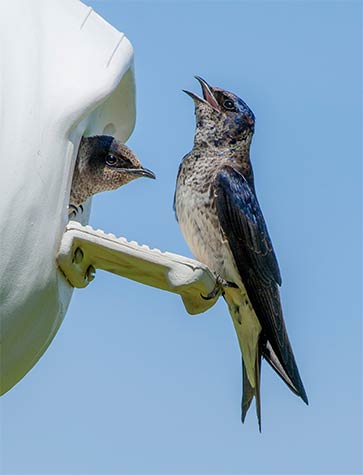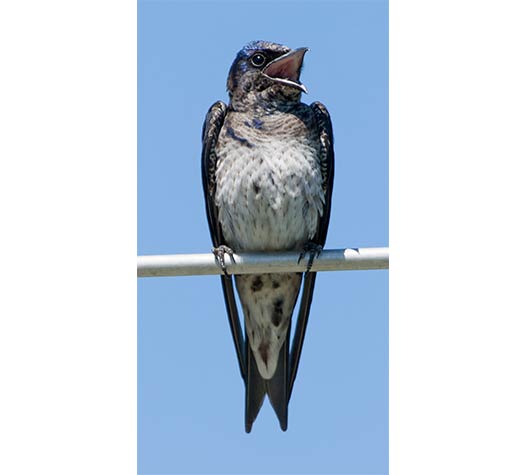Vocalizations
Vocalizations are a major form of communication in animals, and can range from alarms calls to courtship calls. Vocalizations develop as the martins grow. The songs are longer, more complex vocalizations that seem like an actual song to the human ear, whereas bird calls are shorter, usually one or two syllables in length. Songs are commonly used during courtship and mating, while calls are commonly used to show alarm or location.

|
Vocalization Name |
Who Uses/Performs It |
Description/Purpose of Vocalization |
|
Juvenile Calls |
Juvenile martins |
• Given at fledging time • Monosyllabic • Used when begging for food from parents, or when other martins approach the nest • Also used to alert parents that they are being harassed by predators • Used on their first flight |
|
Choo Calls |
Females |
• Used when escorting fledglings back to the nest • Used when taking fledglings out to forage • Mainly at dusk |
|
Zwrack Calls |
Males and females |
• Used during alarm or highly aggressive situations • Given singly • Used when predator gets too close to the nest, causing the martin to dive-bomb |
|
Hee-Hee Calls |
Males |
• Related to territorial defense; usually given after chasing away an intruder • Given in a series of 4 – 10 calls • Often given during intraspecific (same species) combat |
|
Zweet Calls |
Males and females |
• One-syllable call • Indicate alarm • Given in flight when martins fly away from a terrestrial predator, causing others to be more vigilant • Shows excitement • Males use this call if they see another male attempting to copulate with his mate |
|
Cher Calls |
Males and females |
• Most common vocalization • Used in many situations including during courtship, when showing contentment, when excited, and when approaching housing • Sometimes used in conjunction with Zweet and Zwarck calls • Given when in flight and when at rest • Usually accompanied by wing and body shaking • Used mainly during the day but also during pre-dawn hours |
|
Chortle Calls |
Males and females |
• Consists of many syllables • Sometimes used in conjunction with the Cher call • Usually when showing higher excitement levels • Both during the day and predawn • While sitting |
|
Croak Songs |
Males |
• Main courtship song • Directed at mate during egg laying • Given both before and after copulation • Also performed during extra-pair copulations • Given in flight and while perched • Performed after being rejoined with his mate after being separated for a length of time |
|
Chortle Songs |
Females |
• Heard most often during pair formation • Mainly during courtship • Given towards other females when approaching their territory |
|
Subsongs |
Males |
• Only heard near the end of the nesting season, after breeding • Performed in a variety of situations • Most common after birds began feeding their young • Also common during roosting before migration |
|
Dawnsong* |
Males |
• Loudest Purple Martin vocalization • During early morning hours to attract other subadult males, and thus females to the colony site • Only sung after the male has established a nest |
Croak sound file
Dawnsong sound file
—Descriptions by Charles R. Brown; Vocalizations of the Purple Martin
*Description of Dawnsong by Eugene Morton; A Purple Dawn

